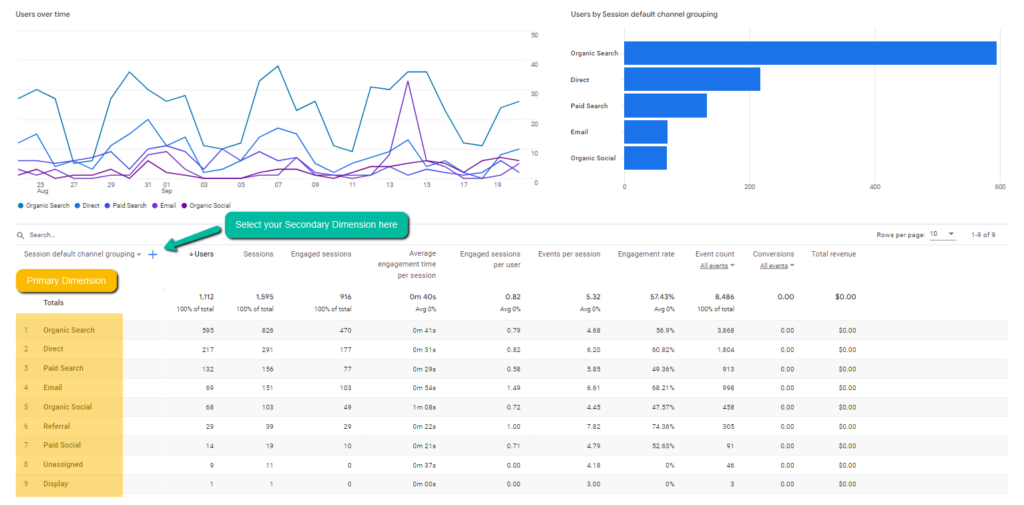The Power of Google Analytics Secondary Dimension: Optimizing Insights
The Power of Google Analytics Secondary Dimension: Optimizing Insights
Blog Article
Opening the Power of Secondary Measurement Analytics for Improved Information Insights and Decision-Making
In the realm of information analytics, primary measurements frequently take the limelight, but the true deepness of understandings lies within the world of additional measurements. By using the power of additional dimension analytics, companies can unveil hidden patterns, reveal connections, and remove much more meaningful conclusions from their information.
Value of Additional Measurements
Checking out the significance of secondary dimensions in analytics introduces the hidden layers of information insights essential for notified decision-making in different domain names. Secondary dimensions offer a much deeper understanding of main information by providing added context and point of views. By integrating second dimensions into analytics, companies can extract much more nuanced and thorough understandings from their datasets.
One secret significance of additional dimensions is their capacity to segment and categorize primary data, enabling an extra comprehensive analysis of details subsets within a dataset. When looking at the data as a whole, this division makes it possible for services to determine patterns, trends, and outliers that may not be evident. Furthermore, second dimensions assist in revealing correlations and dependences in between different variables, bring about even more accurate projecting and predictive modeling.
Additionally, additional dimensions play a vital duty in enhancing data visualization and coverage. By adding secondary dimensions to visualizations, such as graphes or charts, experts can develop much more informative and useful depictions of data, assisting in much better interaction of findings to stakeholders. Generally, the combination of secondary dimensions in analytics is critical in unlocking the complete possibility of data and driving evidence-based decision-making.
Trick Benefits of Making Use Of Secondary Measurements
Using secondary dimensions in analytics offers organizations a critical advantage by enhancing the depth and granularity of information insights. By exploring data utilizing second dimensions such as time, place, device type, or user demographics, organizations can discover patterns, fads, and correlations that might or else stay hidden.
Furthermore, the use of second dimensions enhances the context in which primary data is translated. By leveraging second measurements in analytics, organizations can harness the full potential of their data to drive far better decision-making and accomplish their organization goals.
Advanced Data Analysis Strategies
A deep dive into sophisticated data analysis techniques reveals advanced techniques for extracting beneficial understandings from complicated datasets. One such method is device knowing, where algorithms are employed to identify patterns within data, forecast results, and make data-driven decisions. This method permits for the automation of analytical design structure, making it possible for the handling of huge quantities of data at a quicker pace than typical methods.
Another advanced method is predictive analytics, which makes use of statistical formulas and maker learning methods to forecast future outcomes based on historical information. By assessing patterns and patterns, companies can prepare for customer behavior, market fads, and possible risks, encouraging them to make positive decisions.
In addition, message mining and view evaluation are important methods for extracting understandings from disorganized information sources such as social networks comments, client evaluations, and study responses. By analyzing message data, companies can recognize customer opinions, determine arising look at these guys fads, and improve their services or products based on comments.
Enhancing Decision-Making Via Secondary Measurements

Enhancing decision-making through secondary measurements makes it possible for organizations to make more notified and targeted calculated selections. By segmenting consumer information based on secondary dimensions like purchasing background or involvement levels, companies can tailor their advertising and marketing methods to specific audience sectors, leading to boosted conversion rates and consumer fulfillment. Second measurements can help recognize correlations and relationships between different variables, allowing companies to make data-driven choices that drive growth and profitability.
Implementing Second Dimension Analytics
When integrating additional dimensions in analytics, organizations can unlock deeper understandings that drive critical decision-making and boost general performance. This requires comprehending the particular inquiries the company seeks to answer and the data points called for to resolve them.

Additionally, organizations ought to utilize advanced analytics devices and innovations to simplify the process of incorporating additional measurements. These devices can automate data handling, evaluation, and visualization, permitting companies to concentrate on interpreting insights as opposed to hands-on information adjustment.
Conclusion
In conclusion, second measurement analytics play an learn the facts here now important role in enhancing data insights and decision-making processes. By using innovative information evaluation strategies and applying second measurements properly, organizations can open the power of their information to drive critical business choices. The essential advantages of making use of additional measurements can not be overstated, as they supply a much deeper understanding of information trends and connections. It is necessary for companies to leverage additional dimension analytics to remain competitive in today's data-driven landscape.
In the world of data analytics, main measurements frequently take the limelight, however the you can look here real depth of insights lies within the realm of second measurements.Making use of additional measurements in analytics offers organizations a critical advantage by boosting the deepness and granularity of information insights. By leveraging secondary measurements in analytics, organizations can harness the complete potential of their information to drive much better decision-making and accomplish their business goals.
Implementing information recognition processes and routine audits can help maintain information top quality and integrity.
By making use of sophisticated information analysis techniques and applying secondary dimensions successfully, organizations can unlock the power of their data to drive critical organization decisions.
Report this page